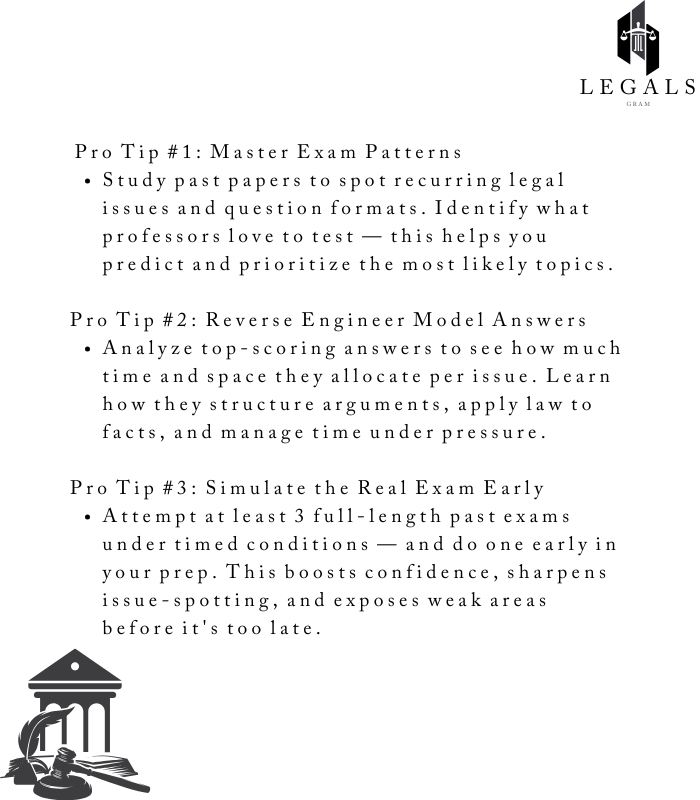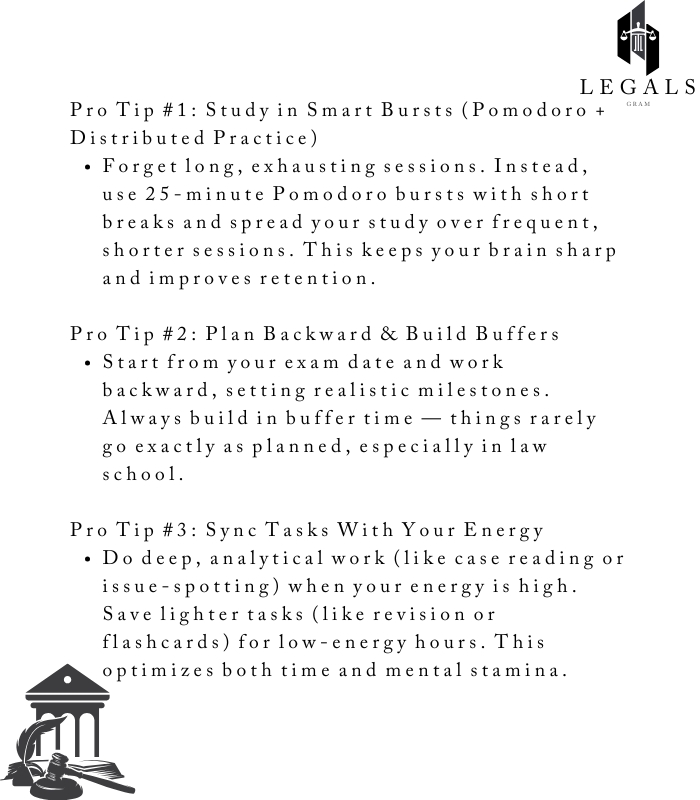The experience of taking law school exams is quite different from that of taking tests in college or university. Because of how results are measured, how fact patterns are formed and how much competition there is, the way you study for exams can decide if you end up like everyone else or ahead of the pack. Using these strategies has helped law students do better on their exams and increase their GPAs.
1. Create Strategic Course Outlines Throughout the Semester
The key to doing well on law school assessments is having thorough and orderly course outlines. Even so, the simplest way to outline is often not the way that most students begin.
What Makes an Effective Law School Outline:
- Progressive development: Begin outlining within the first two weeks of class and update weekly
- Hierarchical structure: Organize material with clear main topics, subtopics, and key cases
- Integration of multiple sources: Combine class notes, casebook material, and supplementary readings
- Rule statements: Craft precise statements of legal rules that can be directly used during exams
- Case summaries: Include brief case summaries highlighting only the essential holdings and reasoning
- Personal annotations: Add your professor’s specific interpretations or emphases
- Visual elements: Incorporate flowcharts, tables, and other visual aids for complex topics
Professor James Davis from Harvard Law School notes: “Students who view outlining as an ongoing process rather than a pre-exam task consistently demonstrate deeper understanding on exams. The outline becomes a thinking tool, not just a reference document.”
Implementation Tip: Plan to spend 45 minutes twice a week, for each course, setting up an outline. It stops students from facing the huge task of making complete outlines while they are reading their books.
2. Master the IRAC Method with Deliberate Practice
You should build your answer to a law school exam using the IRAC framework. Though many students know how to use this method, most don’t train it properly enough to rely on it during an exam.
Effective IRAC Mastery:
- Issue spotting drills: Practice identifying issues in short fact patterns with increasing complexity
- Rule memorization: Create flashcards for precise rule statements in each course area
- Application workshops: Practice applying rules to varied fact patterns, particularly with ambiguous facts
- Feedback loops: Exchange practice answers with study partners to identify weaknesses
- Timed practice: Gradually decrease allowed time for IRAC analysis of individual issues
Research Insight: Looking at law student grades, those who practice the IRAC approach with 25 different questions get much better results than those who learn it just by reading about it.
Implementation Tip: Create a library of practice questions by converting cases from your readings into fact patterns by removing the court’s analysis and conclusion.
3. Deconstruct Past Exams from Your Professor
Your professor’s old exams probably offer the greatest value because they reveal how problems are usually given which topics are covered and the depth expected from your answers.
Effective Exam Deconstruction:
- Analyze question patterns: Identify recurring issue types and question formats
- Study model answers: Compare multiple strong answers to understand various successful approaches
- Time allocation analysis: Note how much space/time model answers dedicate to each issue
- Professor feedback review: If available, study feedback comments to understand expectations
- Issue prediction: Create a list of most-likely-to-be-tested issues based on historical patterns
- Practice simulation: Take at least three past exams under timed conditions, including one early in your preparation

According to Professor Sarah Johnson at Yale Law School, students who pay close attention to her previous exam questions usually achieve good results in new exams. Even knowing how the format works is limited when compared to the lessons I gain in this process.
Implementation Tip: Make a document for every subject, describing your professor’s manner of analyzing information, organizing their ideas and deciding on the main issues.
4. Implement Spaced Repetition for Rule Memorization
Taking law exams means remembering instantly a wide range of rules, elements, tests and exceptions. Reliable long-term learning is best supported by spaced repetition systems (SRS) methods.
Effective Spaced Repetition Techniques:
- Digital SRS tools: Utilize applications like Anki or Quizlet for systematic review
- Rule flashcards: Create cards with rule statements, elements, and key case applications
- Critical case flashcards: Focus on landmark cases that established or modified important rules
- Review schedules: Follow algorithmically determined review timing rather than cramming
- Interleaved practice: Mix flashcards from different courses to strengthen distinctions between similar concepts
Research Insight: A 2018 study in the Journal of Legal Education found that law students using spaced repetition methods scored an average of 7.2% higher on rule-intensive exams compared to students using traditional study methods.
Implementation Tip: Begin creating your SRS flashcards when you start your course outlines, adding approximately 5-10 new cards per class session.
5. Form a Strategic Study Group with Clear Protocols
The effectiveness of a study group depends only on how it is arranged and who participates, as well as what its focus is. The top performing study groups create an environment for learning together, not for hanging out.
Effective Study Group Strategies:
- Size optimization: Limit groups to 3-5 members for maximum engagement
- Complementary strengths: Include members with different academic backgrounds and analytical styles
- Scheduled sessions: Set regular meetings with predetermined agendas and time limits
- Assigned responsibilities: Rotate teaching roles for different topics to ensure preparation
- Active learning formats: Use techniques like moot courts, issue-spotting competitions, and rule challenges
- Feedback mechanisms: Incorporate constructive criticism protocols for practice answers
- Individual preparation requirements: Establish clear expectations for pre-meeting work
Professor Michael Chen from Columbia Law School notes: “The difference between effective and ineffective study groups isn’t intelligence—it’s structure. Groups that implement specific protocols consistently outperform those with casual approaches.”
Implementation Tip: Create a study group contract outlining meeting frequency, preparation expectations, and participation requirements to ensure accountability.
6. Develop Subject-Specific Attack Plans
Different law school subjects require customized approaches based on their underlying structure and common testing patterns. Creating subject-specific “attack plans” allows for more targeted preparation.
Subject-Specific Strategies:
For procedural courses (Civil Procedure, Evidence):
- Create comprehensive flowcharts showing decision trees
- Practice identifying procedural postures and their implications
- Master timeline analysis for sequence-dependent rules
For code-based courses (Tax, UCC, Bankruptcy):
- Develop section-number recall through frequent practice
- Create application hierarchies for multi-section analysis
- Practice statutory interpretation techniques specific to that code
For common-law courses (Torts, Contracts, Property):
- Focus on majority/minority rule distinctions
- Create jurisdiction-specific rule variations
- Practice policy analysis for evolving doctrines
For constitutional courses:
- Master tier-based analysis frameworks
- Create comparison charts for competing interpretive approaches
- Develop historical context summaries for major doctrines
Implementation Tip: Create a one-page “attack sheet” for each course outlining the specific analytical approach and organization method you’ll use during the exam.
7. Implement Strategic Time Management for Exam Preparation
Effective exam preparation requires more than just studying hard—it demands studying smart with deliberate time allocation based on scientific principles of learning and retention.
Evidence-Based Time Management Approaches:
- Distributed practice: Schedule shorter, frequent study sessions rather than marathons
- Peak performance timing: Schedule deep work during your personal optimal cognitive hours
- Pomodoro technique: Use 25-minute focused sessions with 5-minute breaks
- Interleaving: Alternate between subjects rather than blocking entire days for single courses
- Buffer scheduling: Build in “overflow time” to account for unexpected challenges
- Backward planning: Start from exam dates and map preparation milestones backward
- Energy management: Align task types with energy levels (creative work during peak hours, review during lower energy periods)

Research Insight: Studies show that students who distribute their study time across multiple sessions achieve up to 30% better retention than those who engage in equivalent-length cramming sessions.
Implementation Tip: Create a detailed exam period calendar with color-coded blocks for different courses and activity types (outlining, practice questions, flashcard review, etc.).
8. Utilize Active Learning Techniques
Passive reading and highlighting represent the least effective study methods according to cognitive science research. Active learning techniques force your brain to engage with material more deeply, significantly improving understanding and retention.
High-Impact Active Learning Methods:
- The Feynman Technique: Explain concepts in simple language as if teaching a novice
- Case briefing variations: Brief cases using different organizational structures to deepen understanding
- Concept mapping: Create visual representations showing relationships between legal concepts
- Self-testing: Generate and answer your own hypothetical questions
- Verbal rehearsal: Practice articulating analysis aloud as you would in an exam
- Reverse engineering: Work backward from answers to understand analytical processes
- Synthesizing activities: Combine multiple cases or rules into unified frameworks
Law professor and learning expert Elizabeth Adams explains: “The strongest indicator of exam success isn’t time spent studying, but the percentage of that time spent in active rather than passive engagement with material.”
Implementation Tip: For every hour of reading, schedule at least 30 minutes of active processing using one of these techniques.
9. Create Condensed Study Materials for Final Review
As exams approach, having strategically condensed materials allows for efficient final review without overwhelming yourself with comprehensive outlines.
Effective Condensation Strategy:
- One-page attack sheets: Create single-page overviews showing key frameworks for each course
- Rule inventories: Compile comprehensive lists of all testable rules with minimal explanatory text
- Issue checklists: Develop systematic checklists for issue spotting in different fact pattern types
- Visual summaries: Create flowcharts, decision trees, and comparison tables for complex areas
- Memory triggers: Develop mnemonics or acronyms for multi-part tests or element sets
- Case mapping: Link key cases to their corresponding rules and exceptions
Implementation Tip: Create these condensed materials at least two weeks before exams while your understanding is fresh, rather than attempting to create them during the immediate pre-exam period.
10. Simulate Exam Conditions with Increasing Fidelity
The single most predictive factor for exam success is the number of full-length practice exams completed under realistic conditions. Progressive simulation helps build not only knowledge but also the specific performance skills needed during actual exams.
Effective Exam Simulation:
- Progressive time pressure: Begin with untimed practice, then 150% time, then actual time constraints
- Environmental matching: Practice in settings similar to your exam location (library, classroom)
- Technology alignment: If using exam software, practice with the same platform
- Stress management practice: Incorporate stress-induction elements to build resilience
- Full answer production: Write complete answers rather than just outlines or issue identification
- Self-assessment: Review and score your practice answers using rubrics from past exams
- Recovery simulation: Practice recovering from time management problems or difficult questions
Professor William Thompson of Stanford Law School notes: “The students who perform best aren’t necessarily those with perfect understanding, but those who have practiced the specific skill of taking law school exams until it becomes second nature.” Ever wondered how Criminal Defense Lawyer charge their clients?
Implementation Tip: Schedule at least three full-length practice exams per course, with the final one occurring 3-5 days before the actual exam.
Conclusion: Implementing Your Personal Exam Success System
Law school success doesn’t come from studying harder than everyone else—it comes from studying smarter. The ten strategies outlined above represent evidence-based approaches that have helped countless students transform their exam performance and boost their GPAs.
The secret to using these strategies successfully is to customize them. Law students all learn in their own way and may face different difficulties. Assess how you have been studying so far, figure out their strengths for your issues and use them in stages during the semester.
Remember that excellence on law school exams isn’t mysterious or dependent on innate legal brilliance. It’s the product of deliberate, consistent application of proven learning methods combined with strategic preparation tailored to the unique demands of legal education. By implementing these ten crucial study tips, you’ll position yourself for exam success and the GPA boost that comes with it.
Your future legal career begins with the foundation you build in law school. Make these strategies part of your academic toolkit, and you’ll not only see improvement in your grades but also develop the analytical skills that will serve you throughout your professional life.



